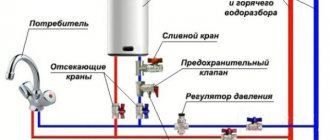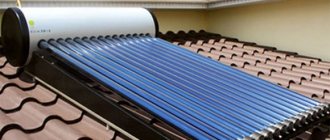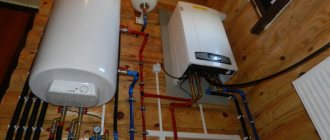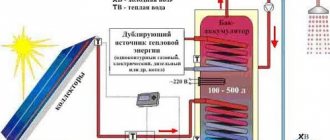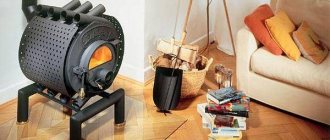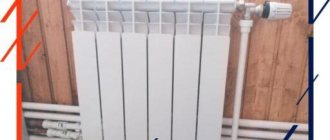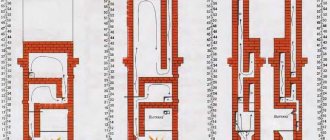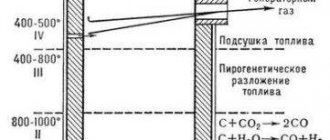01/26/2017 master
Recently, non-traditional methods of heating rooms have become increasingly relevant. People are striving to find a more efficient and cheaper way to heat their homes. One such method is to use solar energy.
Solar heating for home
Today, special collectors are used to transform solar energy into thermal energy. Our article will tell you how you can heat your home using such devices.
Design features of solar heaters
In order to equip a full-fledged home solar system, or “solar heater,” you will need to purchase several photocells, which are interconnected during installation. Such modules are durable wafers made of silicon. The cost of plates directly depends on their quality. The higher the “purity” of photocells, the stronger they are and the greater their efficiency.
Types of solar heating collectors
The following types of solar heating collectors are currently used:
- flat;
- vacuum
They differ from each other in the device for transmitting the radiant energy of the Sun.
homemade collector
In a flat solar heating collector, the device for collecting such energy is a box filled with special adsorbent materials. The heat supply system pipelines are laid in the thickness of the material. The liquid circulating through them is heated by exposure to sunlight and is then discharged into the heat accumulator tank.
Instead of a flat box, a vacuum heating manifold uses a system of transparent tubes from which air is evacuated. Inside the tubes there are heat supply system pipelines of various configurations. An interesting physical effect of such a device is that the sun's rays pass unhindered through the outer layer of glass and the vacuum, and then heat the liquid in the pipelines. But the heat from the liquid in the pipelines no longer flows back, since vacuum is an excellent heat insulator. All in all. This design in miniature resembles our planet: after all, we also have a heat insulator in the form of interstellar vacuum, which, nevertheless, does not prevent the sun’s rays from effectively heating the earth.
Modules for solar systems come in two types:
- with frame;
- without frame.
In any case, it will be necessary to connect several modules in a certain sequence in order to obtain the technical parameters necessary for their safe operation. A special substrate provides additional strength to the frame solar battery. The material for its manufacture is durable tempered glass. It transmits sunlight well and reliably protects silicon panels from precipitation and mechanical influences.
On the inside of the frame structure there is protection made of laminate, and for additional insulation, the elements are placed in a film resembling polyethylene. The ends of the frame are finished with an aluminum profile, glued with adhesive-sealant. The purpose of the profile is to support the structure above the roof in such a way that a certain distance remains between the elements and the roof.
Frameless solar heaters are produced on a textolite substrate. There are models without a backing, covered on both sides with a lavsan film, with all photocells carefully sealed.
Constructions
What will the store shelves offer? Today there are two designs available:
- frame;
- frameless.
In addition, you will purchase photocells separately. The difficulty of using the devices correctly falls on the shoulders of the buyer.
Common features
Regardless of the presence of a frame, each solar battery is made up of modules formed by photocells connected in series, parallel or in a mixed way. The latter will allow you to obtain the necessary voltage and power. Within the node, close attention is paid to the characteristics of the photocells. The overall properties of the structure are determined by the worst value of the parameter. For example, in a series circuit, the current is limited by the maximum internal resistance of the photocell.
Solar panels on the roof of a house consist of myriads of modules, packaged in the same way as mentioned above. Let's discuss the differences.
Frame solar panels
The tempered glass substrate provides reliable protection for sheet solar panels applied on one side. Rain, snow, hail will not damage the source of autonomous power supply. Transparent glass easily transmits light and prevents mechanical damage to photocells. On the inside, the batteries are protected by layers of laminate. Dacron (polyester) is used.
For additional sealing, the photocells are embedded in a film similar in properties to polyethylene. The ends are finished with an aluminum profile mounted on a sealant, preventing delamination of the cake, which - starting from the outer surface - looks like this:
- Durable layer of tempered glass.
- Photocells embedded in film.
- Laminate inner layers.
The aluminum profile is shaped like the letter F and supports the structure at a certain distance from the roof surface. A single element will not provide sufficient output voltage; a number of pieces are connected in series. The frame structure is complemented by electrical connection elements.
Frameless solar panels
In this version there is no frame. The substrate will be fiberglass, or the substrate will be completely absent. In the latter case, both sides are covered with lavsan film. Photocells are carefully sealed.
Taking into account environmental factors
Solar home heaters operate optimally under the following conditions:
- at a temperature of +25C;
- with a luminous flux of 1000 W/m2;
- in the AM spectrum 1.5.
The abbreviation AM denotes the spectrum of the Sun, which is observed in the mid-continental latitudes of the United States. It is based on them that it is customary to test the parameters of all solar systems. The AM latitude is located south of Moscow and in Russian regions it is usually designated where Rostov-on-Don or Volgograd are located.
What are solar panels?
Solar panels are a high-tech device that converts the inexhaustible energy of the sun into electrical energy. Such devices have been widely used for several decades and work successfully in many household appliances, such as watches or microcalculators. Modern production has made it possible to make the production of solar panels quite cheap, which has made it possible not only to power miniature devices from them, but also to create, based on solar energy, autonomous systems of relatively large sizes for heating country houses and ensuring a stable energy supply in them.
Advantages of solar panels
Despite the rather high starting cost of equipping a private home with a full-fledged package of solar panels, the overall operating cost of such equipment is relatively low, since in the end the price of a kilowatt-hour will consist only of the starting costs of the purchase and the price of the necessary maintenance work. Divided by the rather long service life of such equipment, the final price per kilowatt hour will rapidly fall.
Heating water for heating using a solar collector
In homes where people live all year round, collector-type heaters are becoming very popular. As a rule, they are installed on roofs so that there is no need to equip a bulky pipe heating system at home. In China, buildings have long been built that are pre-equipped with collectors powered by solar energy. In Russian latitudes, they are most often used in the countryside to heat water in the summer.
The main structural elements of the collector are coaxial vacuum tubes (external water conduit). They are painted with a dark dye that absorbs light rays. The cross-sectional diagram of the collector looks like two cylinders inserted into each other according to the principle of coaxiality. The internal conduit is made of copper. Its heating occurs due to thermal radiation from the walls of the external water conduit.
The process of heating water occurs as follows:
- the dark dye on the outer tube absorbs sunlight;
- heat gradually accumulates in the tube;
- its inner walls are heated;
- the walls begin to give off heat;
- thermal energy passes through the vacuum space inside the system, entering the tube containing the water;
- The water is heated, and its accumulation occurs in the tank, from which it is already consumed.
The collector may be included with the solar system. It depends on the manufacturer. If it is not included in the package, it can always be purchased separately.
Hot water is obtained from the collector not only in summer, but also in cold weather. To do this, the system will require constant care: you will need to regularly remove snow and ice from the pipes. If the attic window of your house faces south, it will not be difficult for you to install a collector there, isolating the water supply from external conditions. Typically, insulation of a water pipeline is done using glass wool or penofol.
Solar energy for heating
The main purpose of energy storage photovoltaic cells is to provide electricity to the home. To include them in the heating system design and achieve optimal functioning, it is necessary to assemble a circuit with a storage tank.
It is in it that the water will be heated, which, having reached a certain temperature, will fill the pipes and radiators in the rooms that require heating (living room, bathroom).
A system powered by solar energy, with a double-circuit tank that organizes heating and supply of hot water in two directions: to heating radiators and to distribution points (+)
Let's try to analyze the design features of solar panels and determine their potential role in the heating system.
The principle of operation of panels with photocells
There are three common types of elements for solar panels:
- Monocrystalline . These are thin wafers of the purest silicon, cut from a crystal grown under artificial conditions. The most productive variety with an efficiency of about 17-18%. The optimal temperature for operation is from 5 ºС to 25 ºС.
- Polycrystalline . Made from wafers obtained by gradual cooling of silicon melt. The technology for their production is less labor-intensive, but the efficiency of photovoltaic elements made from polycrystalline is significantly lower - no more than 12%.
- Amorphous. They are film. Manufactured by the evaporation phase method, as a result of which silicon in the form of a thin film is deposited on a flexible polymer base. The cheapest production method is combined with low productivity, estimated at up to 7%.
For the installation of autonomous heating systems in the northern regions, photovoltaic batteries assembled from monocrystalline elements are considered the most suitable option. However, batteries with amorphous modules are easier to install, practically do not require a base and are much cheaper.
A monocrystalline module consists of series-connected elements combined into modules. Several modules form a solar battery. The dark surface of solar photovoltaic systems optimizes the absorption of solar rays
The task of external elements is to absorb and transform the sun's rays. The released energy goes further and is concentrated in the storage tank. A small element produces about 100-250 W, and a prefabricated panel of 25-30 m² provides electricity to a small house. Installing a heating system will require 2-3 times more energy.
An inverter acts as a converter of direct current from solar “production” into electricity, since alternating current is required for the operation of household electrical appliances and lamps.
If we talk specifically about the heating system, an electric boiler for heating water also runs on alternating current. To provide light to your home at night, you will need batteries that store daytime supplies.
Inverter modules are installed in a place convenient for maintenance, although it does not require constant control and operates in automatic mode (+)
Efficiency of using photocells
The easiest way is to purchase solar collectors and use one of the simple schemes that have been proven over the years. However, circumstances sometimes dictate their own conditions. Let's say you have a great functioning solar generator system, but for now it only serves to supply electricity and provide hot water to your home.
It is clear that buying new equipment is unprofitable, so it is easier to increase power by purchasing a certain number of photoelectric converters. Budget option - silicon panels with productivity up to 23-25%.
It is necessary to connect a heating device that runs on electricity to the current source. A universal option is a boiler equipped with distribution wiring.
Polymer film elements are much less common on the Russian market than silicon mono- and polycrystalline analogues. They are easy to install, but have low efficiency - only 6%
If the electricity supply is properly organized, it should be enough for both hot water supply and heating. There are examples when the house is fully provided with heat - it can be recognized by the roof, almost completely covered with panels.
Sometimes it is necessary to erect special free-standing structures if the roof area is not enough. It turns out that to increase power, additional free space is needed.
Even the most careful calculations will not help you determine the exact amount of potential energy and quickly create an effective, well-functioning system. The fact is that in practice obstacles arise, the appearance of which is quite difficult to predict.
Here are some of the factors:
- Inconsistency of weather. The exact number of sunny days is unknown even in the southern regions. It is almost impossible to reliably predict their number in the northern regions.
- Irregularity of receiving electricity. For example, in the northern regions there are short daylight hours in winter, so a lot of recycled solar energy is spent on lighting. In addition, the intensity of solar radiation in winter decreases significantly.
- Periodic breakdowns . Like all technical systems, solar panels can fail from time to time due to damage to individual elements, contract connections, protective surfaces, etc.
Consequently, you can find out about the effectiveness only after a certain period of time, at least after a year. It may be necessary to increase the number of photocells or batteries, consider additional thermal insulation of the house, and reduce the heated area. Suppose that in the northern regions of Germany, in order to save money, bedrooms are often not heated at all.
Maintenance of installed photocells does not require special skills and consists of regular cleaning: removing snow in winter and debris in warm periods, washing the glass surface with water from a hose
Home power plant installation diagram
The easiest way to install a solar generator is to contact a company that sells system components and offers installation services. Pros - a professional project taking into account individual characteristics, a guarantee for all products and installation, minus - high cost.
If you have relevant experience, you can independently assemble a mini-power station with solar panels for heating a private home.
The most effective is considered to be a hybrid scheme for the design of an air-solar system, in which photocells are used to generate energy, collectors for heating water, and an additional wind generator is installed. It can be replaced with a backup fuel source (+)
All parts for assembling the heating system are sold in specialized stores.
You must purchase the following components:
- a set of silicon or film solar modules;
- a rechargeable battery that stores energy;
- charge controller that regulates the process of charging and discharging the battery;
- an inverter that converts direct current into alternating current;
- set of connecting cables.
It is desirable that the batteries be the same (taking into account the brand, capacity and even batch) and be able to store energy for 3-4 days. The duration of their operation depends on the room temperature - in cold conditions they quickly discharge. If the daily consumption is 2400 Wh, batteries with a total capacity of at least 1000 Ah are required.
When using car batteries, remember that their maximum efficiency is 70-75% (service life - 3 years), special devices for solar systems have the best performance - up to 85% (service life - 10 years). Some energy is lost during storage and conversion
The quality of the current produced by sine wave inverters for solar systems is higher than that of the current from the centralized network. A special feature of the equipment is the synchronization of the voltage phase, in which the transition from 12 V to 220 V is carried out without interruption in the functioning of household electrical appliances.
Inverter power – from 250 W to 6000 W and above. You can increase the output power by connecting several devices in parallel. For example, 3 x 3000 W = 9000 W (+)
After installing all the elements of the solar system, it is necessary to connect an electric tank that heats the water to the inverter, and to the tank, in turn, a heating pipeline.
Heating by photocells
The classic solar system works a little differently. Photocells accumulate solar energy, which is converted into electrical energy. Getting to the terminals of the silicon panels, direct electric current passes to the inverter, which converts it into alternating current. This produces a current that complies with accepted standards for a household electrical network. Next it goes to the heating elements located in the boiler or heat tank.
To control the temperature of water heating, thermostats are installed that operate in automatic mode. When the water temperature drops, the thermostats are immediately activated, which allows you to maintain stable temperatures.
Unlike collectors, such “solar heaters” heat water not directly, but indirectly, taking into account the generation of electrical energy. It is used to warm up the liquid. Such systems are highly stable and allow not only to accumulate energy, but also to apply it much more evenly than with direct heating.
Prices and solutions
The price per 1 W of power for typical roof-mounted solar panels falls within the range of $4-8. In this case, the supplier often undertakes to cut elements to order or install a standard version. Here is a set of typical solutions provided by solar energy, posted by the company on the official website:
- Energy supply for a private home.
- Equipment for uninterrupted operation of communication stations.
- Solar-powered Wi-Fi hotspot.
- Free-standing lanterns powered by daylight rays.
- Chargers for cell phones.
- Billboards with lights.
- Window glass that can generate energy.
These are quite understandable projects, and others have been developed. Engineer Scott Brusaw proposes making road surfaces from solar panels. This is a truly grandiose project, but a garden made of eco-trees looks much more amazing. Mobile devices can be easily charged from “plants”.
Obvious advantages of the system
So, a solar heater has a number of obvious advantages:
1. Its performance does not depend on weather conditions. Photocells are now being developed that do not lose their efficiency even in extreme cold.
2. The solar system is easy to use and easy to care for. From time to time it is necessary to clean the surface of solar cells from dust, snow and dirt. For ease of cleaning, you must immediately install the kit where it will always have easy access.
3. Solar-powered heaters can accumulate a supply of electrical energy, which is used when operating various electrical appliances or heating several rooms at once.
4. Heating circuits are fully automated and equipped with thermostatic sensors.
5. Initially, you will have to invest a large amount of money in the solar system, but it will pay for itself within the first two years of use. With its help, you get the opportunity to save gas, electricity and even not depend on local heating networks.
6. If there is a need to increase the efficiency and power of the solar system, you can buy several more panels and install them additionally.
7. Other alternative energy sources can be connected to solar panels: for example, wind generators or engines running on gasoline or diesel fuel.
8. Solar energy storage devices are absolutely safe to use, provided that all necessary elements (controller, inverter, etc.) are installed correctly.
9. If you are concerned about the environmental situation in the world, you definitely won’t find a better way to get hot water and electricity.
Options for self-assembly of the heating system
Today, there are several ways to assemble a solar heater with your own hands. Let's look at the most popular assembly methods. First option. Here you need a galvanized container for water. It should have a volume of approximately 100-200 liters. The technology for creating a solar battery has the following algorithm:
- We place the container on the roof. It should be installed on the south side of the roof;
- the roof surface must be covered with a metal sheet with a shiny surface;
- put pipes on top of it;
- we connect them to a barrel and a container for heated water.
Homemade solar collector option
With the help of such a battery, 100 liters of water can be heated by 60 degrees. This installation has high efficiency. But in winter, such a unit will not be effective. Second assembly option. To create this type of collector you will need:
- steel boxes;
- several flat steel radiators;
- glass;
- metal-plastic elements - fittings and pipes.
The system builds in this case proceed as follows:
- steel boxes are mounted on the roof;
- radiators are placed there;
- Cover them with glass on top. This will reduce the water heating time;
- the tubes must be laid with a downward slope;
- be sure to ensure that the top of the device is located below the storage tank;
- A plastic barrel with water is installed in the attic. Suitable volume - 160 l;
- it must be connected to the radiator and water supply using metal-plastic devices - fittings and tubes. The water tube itself needs to be connected slightly above the middle of the tank;
- Drain valves are installed at the bottom of the radiator. With their help, water is drained during the cold season.
Option with plastic barrel
Third option. It is used to heat a fairly large room. Has an efficiency of 45-55%. To create this type of heating system you will need the following materials:
- any thermal insulation material;
- wooden frame with a plywood bottom;
- black metal mesh;
- deflector;
- transparent polycarbonate sheet;
- several fans
The structure is assembled as follows:
- drill round holes in the ramp. They are cut through for air intake;
- to remove hot air we make rectangular holes at the top of the frame;
- We put thermal insulation material on its bottom. A metal black mesh will act as a heat accumulator;
- fans built into round holes;
- then we install the support strips for the deflector. After this, we install the deflector itself. It will shape the air flow;
- We install a transparent sheet on top.
Finished design
With the help of such a unit, you can effectively heat your home, as well as heat water.
Helpful installation tips
As for the subtleties of installation, during installation it is better to lay the panels parallel on the roof. During installation, both the geographic and seasonal position of the Sun should be taken into account. The amount of sunlight and heat that the solar system will accumulate depends on this. If you plan to place panels in several rows, make sure that one row does not cast its shadow on another.
To increase efficiency, it is better to immediately take care of purchasing a solar tracker. This device is always included in the package of the best solar systems. It is designed to follow the movement of the Sun across the sky and rotate the photocells after it. Thanks to this, the heating of the panels will always occur intensively and evenly, which will allow maximum use of their potential.
Before installing the modules, it is necessary to calculate how much electricity the heating circuit consumes. This will help to determine the maximum performance of solar panels.
If you have technical skills, you can try to install the system yourself, but if difficulties arise, it is better to contact an experienced technician.
If you are planning to equip a solar system at home, consider installing a “warm floor” system. This circuit ensures a more uniform distribution and gentle heat consumption than “classic” batteries in the form of radiators.
Pros and cons of an alternative heating system
There are not many advantages of a solar heating system, but each of them is significant and can become a reason for private experiments:
- Environmental benefits. This is a clean source of heat that is safe for the residents of the house and the surrounding environment and does not require the use of traditional types of fuel.
- Autonomy . System owners are absolutely independent of energy prices and the economic situation in the country.
- Economical. By maintaining the traditional heating system, it becomes possible to reduce the cost of paying for hot water supply.
- Public availability . To install solar systems, you do not need permission from government authorities.
But there are also unpleasant moments that can spoil the overall picture. For example, determining the efficiency of the system will require a long period - at least 3 years (provided that there is enough solar energy and it is used actively).
Installing solar modules alone will require large investments: the cheapest silicon panels will cost at least 2,200 rubles. per piece, and polycrystalline six-diode elements of the first category - up to 17,000 per piece. Calculating the cost of 30 modules is quite simple (+)
Users note the following disadvantages:
- high prices for equipment necessary to put the system into operation;
- direct dependence of the amount of heat produced on geographic location and weather;
- the mandatory presence of a backup source, for example, a gas boiler (in practice, a solar system is often a backup).
To achieve greater returns, you have to regularly monitor the serviceability of the collectors, clean them of debris and protect them from the formation of ice during frosts. If the temperature often drops below 0ºC, you need to take care of additional thermal insulation not only of the elements of the solar system, but also of the house as a whole.
Image gallery
Photo from
Solar panels on the roof of a country house
Fastening the batteries of a country solar system
Outdoor solar power plant equipment
Technical devices located inside the house
What else to consider
It has already been noted that solar panels work effectively regardless of whether it is summer or winter outside. However, you should take into account the number of sunny days throughout the year and the general climatic conditions of the area in which you live.
If it often rains in your region and cloudy weather is the norm, you should not rely entirely on the operation of solar cells. In such conditions, there should always be a “backup” option that can be used at any time. Gaining complete independence from the central heating system is possible only in regions with a warm climate.
To fully heat one average room, you will need a panel with a power of 800 W or more. If you want to completely heat the house, you will have to calculate how many photovoltaic cells you will need in a particular case and, when purchasing, proceed from these parameters, taking into account additional equipment.
With constant interruptions in power supply and heat, there should be no doubt about the need to install solar panels. Of course, a full-fledged solar system requires financial costs and consideration of installation subtleties, but it will always come to the rescue in difficult times.
Solar heaters are a great alternative to conventional heating systems. It is environmentally friendly and will always save utility costs. When living in a separate house, you can seriously think about purchasing it, considering all the pros and cons.
Typical diagram of an autonomous electrical network
Solar panels rated 12 V work on batteries and devices for which the voltage is sufficient. The charge controller closely monitors that the equipment is operated in accordance with technical standards. If necessary, the circuit between the solar panel and the batteries is opened.
Household appliances do not work directly with a constant voltage of 12 V; a special converter is used - an inverter. Alternating current with a frequency of 50 Hz and a nominal value of 230 V is already entering the house. The heater is powered by solar panels in an indirect way - through an inverter.
What about network power supply? Solar panels in the yard will allow you not to pay to the state, and even earn extra money.
Programs for the development of the solar industry exist in developed countries, even in Mongolia.
Closed flat solar collectors
The design of the flat collector is an aluminum frame with a special absorbent layer and a transparent coating. This also includes piping and insulation.
Blackened sheet copper with excellent thermal conductivity, ideal for creating solar systems, is used as an absorbent layer. The absorber absorbs solar radiation energy and transfers it to the coolant, which circulates through the adjacent pipeline.
The outer part of the panel is protected in the form of a transparent coating, for the manufacture of which tempered glass was used, resistant to mechanical damage. This allows you to create reliable protection against hail. The transmission band of such glass is 0.4-1.8 microns, which is sufficient for maximum solar radiation. The inner side of the panel has a good thermal insulation layer.
Closed flat panels have a number of undeniable advantages:
- Simple design.
- Highly effective when used in warm regions.
- The presence of a device for changing the angle of inclination of the panel, allowing you to choose the optimal location of the structure.
- Self-cleaning of frost and snow.
- Reasonable price.
- Long service life, high-quality products can last up to half a century.
If the use of the system was included in the building design, then greater benefits can be achieved.
Among the shortcomings, the following attracts attention:
- High heat losses.
- Quite a large mass of the structure.
- High windage of inclined panels.
- Low performance at temperature changes up to 40 degrees.
The scope of use of flat closed panels for heating a house using solar panels is quite wide:
- In summer, the systems fully satisfy the need for hot water.
- Between heating seasons, they can replace gas heating appliances and electric heaters.
